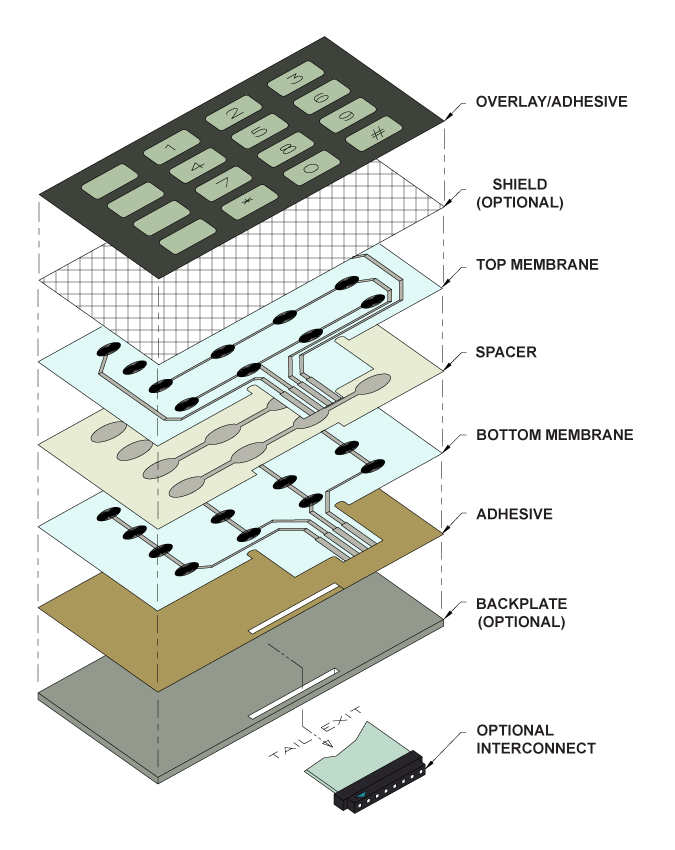Exactly How to Make Sure Durability and Dependability with a High-Quality Membrane Switch
Exactly How to Make Sure Durability and Dependability with a High-Quality Membrane Switch
Blog Article
Comprehending the Performance of Membrane Switches for Interface Devices
The functionality of membrane layer switches over represents a significant improvement in individual interface style, combining efficiency with visual adaptability. As markets significantly focus on individual experience, comprehending the nuances of membrane layer button innovation becomes necessary.
What Are Membrane Switches?
Membrane switches are ingenious user interface tools that assist in user interaction with digital tools. These flexible parts contain multiple layers, consisting of a graphic overlay, spacer, and a printed circuit layer. The style permits a seamless assimilation right into numerous digital devices, improving both the aesthetic and useful aspects of interface.
Membrane buttons are generally employed in a variety of applications, from house home appliances to commercial equipment and clinical gadgets. Their building normally includes a slim profile, making them a perfect choice for small designs. The responsive feedback offered by these buttons can be engineered to satisfy details customer preferences, ensuring effective interaction in between the customer and the device.
Sturdiness is one more considerable advantage of membrane layer switches, as they are immune to dust, wetness, and chemicals, which enhances their life-span sought after settings. In addition, these buttons can be tailored in terms of shape, dimension, and graphic design, permitting branding and user-specific features. On the whole, membrane layer switches over stand for a sensible option for improving individual experience in digital devices, incorporating functionality with aesthetic appeal in an effective way.
Just How Membrane Layer Switches Over Work
Operating on a straightforward principle, membrane layer switches utilize a split construction to register individual input efficiently. Each button contains numerous layers, including a printed circuit layer, a spacer layer, and a top graphic layer, which are developed to interact flawlessly. When an individual presses the top layer, it compresses the spacer layer, bringing the conductive aspects of the circuit layer into call with each other.
This contact develops a shut circuit, signaling the device to perform a certain function. The layout permits for numerous setups, including responsive comments, which can improve the individual experience by offering a physical sensation upon activation. The materials utilized in membrane buttons frequently consist of adaptable substrates, such as polyester or polycarbonate, which guarantee toughness and strength against damage.

Secret Advantages of Membrane Layer Buttons

An additional significant benefit is their compactness. Membrane layer switches are thin and lightweight, which makes it possible for manufacturers to conserve area in their tools without giving up performance. This function is particularly useful in applications where weight and quantity are important considerations.
Furthermore, membrane layer buttons are resistant to dirt, wetness, and chemicals, boosting their longevity. This durability prolongs their life-span and reduces the demand for frequent replacements, leading to cost financial savings in time.
Additionally, the responsive comments supplied by membrane buttons can be optimized to improve customer communication. They can consist of functions such as raised switches or distinct clicks, enhancing usability and customer experience.
Applications Throughout Industries
Individual user interface gadgets using membrane layer switches are common in a large array of industries, showcasing their adaptability and functionality. Membrane Switch. In the have a peek at this website medical industry, membrane layer buttons are important to tools such as analysis equipment and individual tracking systems, where their durability and convenience of cleaning are crucial for keeping health criteria. In a similar way, in the automobile market, these switches are used in dashboard controls and infomercial systems, providing a smooth and modern-day user original site interface for individuals.
Additionally, the consumer electronics industry take advantage of membrane layer switches in home appliances and handheld devices, where compact design and user-friendly user interfaces improve individual experience. Industrial applications also utilize membrane layer changes for control board in equipment and automation systems, stressing their effectiveness and resistance to extreme settings.
In the aerospace and defense sectors, membrane switches are utilized in cabin controls and devices, where dependability and performance under severe conditions are extremely important. Furthermore, the pc gaming industry progressively incorporates membrane layer buttons in controllers and game makers, adding to an appealing user experience. Overall, the flexibility of membrane layer switches over enables their extensive use across countless industries, underscoring their significance in contemporary interface style.
Future Fads in Membrane Change Innovation

Furthermore, using sophisticated materials, such as polycarbonate and polyester films, is expected to rise, providing enhanced toughness and resistance to ecological stressors. These products add to the general longevity of membrane layer switches, making them suitable for harsher commercial applications.
Additionally, the unification of wise modern technology, consisting of IoT connectivity, will certainly allow membrane layer switches to communicate with various other tools and systems, helping with a much more interactive customer experience. This trend aligns with the growing demand for wise gadgets across numerous markets, from healthcare to customer electronics.
Last but not least, modification alternatives are anticipated to increase, permitting manufacturers to create bespoke solutions customized to details individual needs and choices. These advancements will certainly position membrane Continue switches as important parts in the development of interface modern technology.
Conclusion
In verdict, membrane switches represent a pivotal improvement in user interface innovation, offering a trusted and flexible remedy for diverse digital applications. As improvements in product science and touch noticing modern technologies continue, the performance and applicability of membrane layer switches are expected to increase, reinforcing their significance in contemporary digital devices.
Report this page